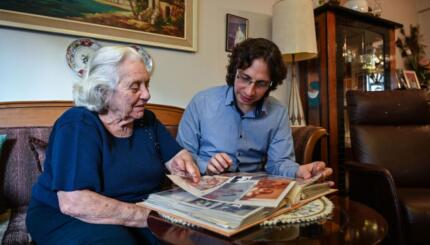The past fifteen years have seen an explosion in Jewish content onscreen, in the United States and around the world. In part, this is due to the American embrace of ethnically oriented subject matter, especially among independent filmmakers. It also has to do with the still-reverberating repercussions of the downfall of the classical Hollywood studio system, and its longstanding prejudice against Jewish content in its films. The influence of Woody Allen, and the impact of the ever-growing number of Jewish film festivals, cannot be overstated either. The combination of these factors has created a burgeoning industry of explicitly Jewish films, and a renewed presence of Jewish content and characters in otherwise mainstream material.
Holocaust Films
The Holocaust became an essential cinematic topic in the 1990s, with the remarkable critical acclaim for Steven Spielberg’s Oscar-winning Schindler’s List (1993) translating into a spate of new Holocaust films, both documentary and fictional.
 Some were equally well-regarded, such as Roman Polanski’s The Pianist (2002), Lajos Koltai’s Fateless (2006), the Oscar-winning documentaries The Long Way Home (1997) and The Last Days (1998), some were travesties, such as Robin Williams’ disastrous Jakob the Liar (1999), and some, like Roberto Benigni’s Life is Beautiful (1998), were disputed properties, attracting huzzahs and catcalls in equal measure.
Some were equally well-regarded, such as Roman Polanski’s The Pianist (2002), Lajos Koltai’s Fateless (2006), the Oscar-winning documentaries The Long Way Home (1997) and The Last Days (1998), some were travesties, such as Robin Williams’ disastrous Jakob the Liar (1999), and some, like Roberto Benigni’s Life is Beautiful (1998), were disputed properties, attracting huzzahs and catcalls in equal measure.
After a long period of relative silence about the Holocaust, broken only by its occasional treatment in films like The Pawnbroker (Sidney Lumet, 1964) and Sophie’s Choice (Alan J. Pakula, 1982), the 1990s saw the dam burst, with a seemingly endless procession of films on the subject.
With your help, My Jewish Learning can provide endless opportunities for learning, connection and discovery.
In particular, there was an interest in telling some of the myriad stories of the Jewish experience in the war years, with most films hewing closely to the careful realism of Agnieszka Holland’s Europa Europa (1990), Jan Hrebejk’s Divided We Fall (2001), and The Pianist.
If the documentaries especially were a mite predictable, and their seemingly annual walk to the Oscar podium a matter having more to do with their subject than their quality, there was genuine hope to be found in the newfound interest of filmmakers to wrestle with the impossible.
There were also some films, like Claude Lanzmann’s Shoah follow-up, Sobibor (2001), and Andre Heller and Othmar Schmiderer’s Blind Spot: Hitler’s Secretary (2002), that made for engrossing, affecting watching. Holocaust iconography even found its way into ostensibly non-affiliated films, like Polanski’s Oliver Twist (2005), or the self-hating Jewish skinhead of Henry Bean’s The Believer (2001).
Perhaps the most impressive Holocaust-related film of the era, other than Schindler’s List, had only a tangential relationship to the subject. Errol Morris’ documentary Mr. Death (1999) began as a study of Fred A. Leuchter, a designer of equipment for various American states’ execution chambers. As the film progresses, Morris steadily reveals more information about Leuchter’s extracurricular pursuits as an ” expert” witness for the case of Holocaust denier Ernst Zundel. Leuchter’s expertise in the mechanics of death leads him, in his infinite foolishness and inflated self-regard, to deem himself familiar with the Nazi death camps, and able to declare that no gas was used to kill at Auschwitz. Morris is less interested in the actuality of the Holocaust than in the astounding delusion of its deniers and critics.
Parody
Not all Jewish-themed films were quite so serious-minded. Seeking inspiration in the blaxploitation films of the 1970s, The Hebrew Hammer (2003), directed by Jonathan Kesselman, parodied Shaft, Superfly, and the other icons of the genre, with a Jewish twist. Adam Goldberg starred as Mordechai Jefferson Carver, a Semitic private eye dedicated to saving Hanukkah from the clutches of an evil Santa Claus hell-bent on eliminating his holiday’s chief rivals to the wintertime throne.
Clever conceit aside, most of the film’s jokes are fairly stale, like the badass Jewish Justice League honcho played by Peter Coyote being named Bloomenbergensteinenthal. Nonetheless, the sight of Goldberg in his tough-Jew costume, sidecurls and all, is good for a few minutes of chuckles, at least.
Religious Life
Religious life in the Jewish community became a subject of interest for filmmakers in the 1990s as well. Two mainstream American films about Hasidism were released–Sidney Lumet’s A Stranger Among Us (1992) and Boaz Yakin’s A Price Above Rubies (1998). The former, starring Melanie Griffith as a police officer who grows entangled with the Hasidic community of Brooklyn during an investigation, was tragically misconceived, while the latter, stronger on the details, was still unable to penetrate the ultra-Orthodox world with much success.
Documentaries like Menachem Daum and Oren Rudavsky’s A Life Apart: Hasidim in America (1997) and Trembling Before G-d (Sandi Simcha Dubowski, 2001) were more insightful, with Dubowski’s film about homosexuality in the Orthodox world, Hasidic and otherwise, sparking an impassioned debate on the heretofore taboo subject.
Comedy and Satire
Judaism in its less overtly religious forms made appearances in a large number of mainstream films, from John Goodman’s Walter (“I don’t roll on Shabbos, Dude”) in the Coen brothers’ The Big Lebowski (1998), to the shofar-toking stoners in Harold & Kumar Go to White Castle (Danny Leiner, 2004), to the 1980’s Jewish summer-campers and counselors of David Wain’s Wet Hot American Summer (2001).
Ben Stiller played a rabbi competing with Edward Norton’s Catholic priest for the affections of a free-spirited woman in Keeping the Faith (2000, directed by Norton), and the indie film Kissing Jessica Stein (2001), directed by Charles Herman-Wurmfeld, was about an uptight Jewish professional woman finding companionship in the arms of a non-Jewish woman. Christopher Guest’s inside-Hollywood satire For Your Consideration (2006) featured a film within the film called Home for Purim, in which a 1950s Southern Jewish matron confronted her daughter’s homosexuality, studded with laughable dialogue and wooden performances.
Judaism became a regular presence in mainstream American film, dependable for a few good laughs or a tug at nostalgic heartstrings. Even the big-budget animated film Prince of Egypt (Brenda Chapman, Steve Hickner and Simon Wells, 1998) adapted the biblical story of Moses’ early years for a mass audience.
Woody Allen
As always, Woody Allen’s films concentrated on a certain subset of upper-middle-class life in contemporary Manhattan, along with semi-nostalgic looks at the Brooklyn of the postwar era. Allen’s unflagging pace (18 films since 1990) made for significant fluctuations in quality, but Deconstructing Harry (1997) was a career highlight. A brilliant meta-fiction, loosely adapted from Ingmar Bergman’s Wild Strawberries, Harry also made use of the best filthy joke about religious Jews ever.
Most of Allen’s output in the post-1990 era was less consistently wonderful, but films like Bullets Over Broadway (1994), Sweet and Lowdown (1999), and Match Point (2005) retained enough of Allen’s legendary comic charm and dramatic insight to please.
French Film
A number of significant Jewish-themed films emerged from France during the 1990s and early 2000s. Mathieu Kassovitz’s La Haine (1995), a film that has grown prescient in the last few years of banlieue unrest, features one Jewish youth among its triumvirate of angry working-class young men battling the law in the rough suburbs of Paris. Jewish himself, Kassovitz grasps the nature of French life at the margins, offering a look at French Jews remarkably different from the stereotypes.
La Petite Jerusalem (2005), directed by Karin Albou, similarly took place in a Paris light-years away from the tourist City of Lights, and was something of a companion piece to La Haine, concerning a young Orthodox woman attracted to secular philosophy, and the world at large. Like La Haine, La Petite Jerusalem was a glimpse at France from the outside in–with Jews firmly barred from the center of French society and culture. Retreating to the start of a previous century, Arnaud Desplechin’s critically acclaimed Esther Kahn (2000) starred Rain Phoenix as an impoverished Jewish naïf who struggles her way to acclaim on the French stage.
International Presence
Jewish concerns, and Jewish filmmakers, popped up elsewhere on the international scene, with films ranging from the heartfelt nostalgia of the British Wondrous Oblivion (2003, Paul Morrison) to the much-lauded Argentinean film Lost Embrace (2004, Daniel Burman), in which a young Jewish businessman wrestles with the notion of leaving his native country for Israel. The raucous German comedy Go for Zucker! (directed by Dani Levy), about a Jewish family in contemporary Berlin, was a major hit in its native country in 2004.
The explosive growth of Jewish film festivals around the world created a boom in Jewish-themed films from unlikely locales, like Wales (Solomon and Gaenor, Paul Morrison, 1999) and Iran (Abjad, Abolfazl Jalili, 2003).
In all this work, there was a unifying sense that Judaism could no longer be brushed under the carpet by cinematic censors concerned for the fragile egos of a majority-Gentile audience, as the Jewish studio chiefs of the 1930s and 1940s had once done. Instead, Jewish content had become part and parcel of the cinematic dialogue, unassuming in its own way, simply another aspect of the world that filmmakers attempted to dramatize, explain, and make sense of.
Hanukkah
Pronounced: KHAH-nuh-kah, also ha-new-KAH, an eight-day festival commemorating the Maccabees' victory over the Greeks and subsequent rededication of the temple. Falls in the Hebrew month of Kislev, which usually corresponds with December.
Hasidic
Pronounced: khah-SID-ik, Origin: Hebrew, a stream within ultra-Orthodox Judaism that grew out of an 18th-century mystical revival movement.


